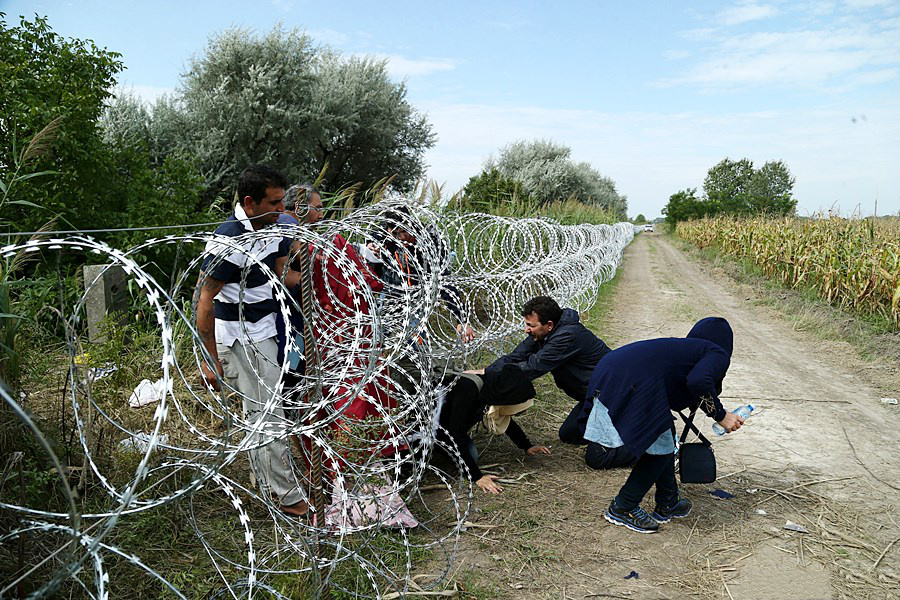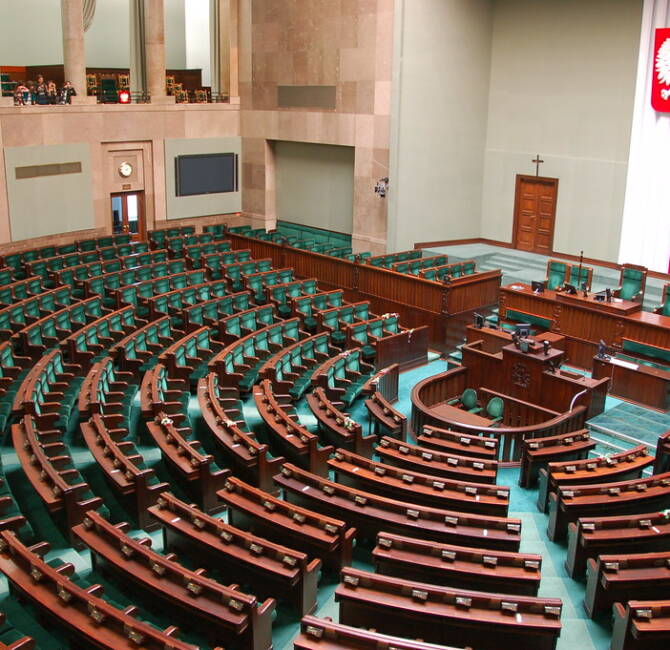Poland – Like the other countries of the former Eastern bloc, Poland long remained highly dependent on Russian hydrocarbons after the fall of communism (in 1989–90) and the departure of the last Russian troops (in September 1993), which ended five decades of occupation by the Red Army.
But since PiS came to power in the autumn of 2015, the diversification of supplies, which was an important pledge in the party’s election platform, has accelerated, allowing the country to be relatively well prepared for a complete cut-off of Russian gas supplies, in spite of this energy source being the most problematic until recently.
Russia’s invasion of Ukraine, which began on February 24, has triggered a race to quickly complete Poland’s transition to Russia-free sources on the path leading to carbon-free energy.
This year, for the first time since the fall of Moscow’s communist satellite regimes in Central Europe, Russia is no longer the main supplier of hydrocarbons to Poland. While Russia’s share in Polish hydrocarbon imports (gas, oil, and coal) was 80% in 2012, during the Donald Tusk era, it was only 53–54% in 2019–21, and had fallen to 44% from January to April this year before dropping to less than 20% during the summer.
Unlike, for example, Germany, whose chancellor has been suggesting a possible return to “business as usual” in the event of a peace agreement between Moscow and Kyiv, Poland has no intention of ever turning back to Russian hydrocarbons.
Gas
This is true in particular for gas, where for years Russia abused its dominant position to impose prices on Poland that were much higher than those offered to its Western European customers, and to apply various forms of economic and political blackmail in order to maintain its influence over its former satellite country after the fall of the USSR.
In a 2015 report concluding five years of investigation by EU authorities, which was leaked to the press in 2018 and has since been made public in a watered-down 2018 version, it was said that Gazprom had made its gas supplies to Poland conditional on decisions regarding control over the Polish section of the Yamal pipeline, which runs through Belarus and Poland to Germany and the Netherlands.
The Polish section of the pipeline long remained under the control of the Russians, who prohibited any resale of gas to neighbouring countries and any reversal of the flow to reimport gas from Germany. Fortunately, those restrictions no longer apply today. Indeed, in 2018, the European Commission succeeded in forcing Gazprom to remove abusive clauses from its long-term contracts imposed on Central and Eastern European countries.
The circumstances under which those long-term contracts were signed sometimes seemed questionable too, with Russia often being accused of using its former Soviet-era networks to influence or corrupt political and economic decision-makers.
In 2010, the European Commission had to intervene to prevent Poland, then governed by Donald Tusk, from signing a contract that would have forced the country to buy at least 11 billion cubic metres per year of Russian gas delivered through the Yamal pipeline until 2037, at prices that were no bargain, while leaving Russia in control of the Polish section of the pipeline.
It looked like Poland had renegotiated to its disadvantage a contract signed in 1996 that covered gas deliveries until 2022. After the European Commission’s intervention, Warsaw and Moscow had to bring forward the projected expiration date of 2037 to 2022 in their new contract.
In 2018, the Polish Court of Audit (NIK) published a report on the matter that was damning to the Polish government of the time and its treasury minister, Waldemar Pawlak, who had been in charge of the negotiations.
In any case, it turns out that the contract that obliged the Poles to buy Russian gas was due to end in December this year, and the Polish state-owned company PGNiG, which was the entity responsible for purchasing the gas delivered by Gazprom, had announced in 2019 that it did not intend to renew it.
This in spite of Polish gas consumption increasing steadily from year to year, with only 2022 marking a reversal of the upward trend, as gas consumption is now falling for the first time in years.
While Polish electricity production is still mainly based on coal (accounting for about 70%) and renewable energy, gas has replaced coal as the source of heating in many individual houses and housing blocks. Poland consumed 23.42 billion cubic metres of gas in 2021 compared with 18.2 billion in 2015.
In this country of 38 million people, gas is used as a heating source by about 2 million households, compared with some 4.3 million households who still use coal. Until now, gas has been the first choice for individuals switching from coal, but that may be about to change with the rising cost of gas, in spite of regulated prices.
If Poland can afford to abandon Russian gas for good, it is primarily thanks to the opening of the Świnoujście liquefied natural gas (LNG) terminal near the German border on the Baltic Sea in late 2015.
That terminal received its 200th LNG tanker on 1 December, and by then 52 had been received this year alone. Poland’s Świnoujście LNG terminal is now being expanded to further increase its capacity. In all, since the start of its operation, it has allowed the import of 21 billion cubic metres of gas (after regasification). From 2024 on, it should be possible to import up to 8.3 billion cubic metres of gas per year through this terminal.
In the meantime, by 2021, before the Russian war in Ukraine, the share of gas imported to Poland by sea in the form of LNG had already risen from under 8% in 2016 to over 24%. Of the 200 deliveries from 2016 to 1 December, 2022, 110 were from Qatar, 72 from the United States, 13 from Norway, 3 from Nigeria, and 2 from Trinidad and Tobago.
The other major source of imports, since this autumn, is the Baltic Pipe, a flagship project of PiS which had earlier been abandoned by the previous post-communist and liberal governments. Being connected to the North Sea gas pipeline networks, the Baltic Pipe can carry Norwegian gas to Poland through Denmark.
Its maximum capacity is 10 billion cubic metres per year. It was commissioned on 27 September and became fully operational on 30 November. Its construction was co-financed by the European Union, and it enables gas to be transported from the Norwegian continental shelf, where Poland’s PGNiG holds 19 concessions.
In addition, in September 2020, the Port of Gdańsk, Gaz-System (the state-owned company in charge of gas transportation in Poland, which owns the Baltic Pipe and the LNG terminal in Świnoujście), and the Gdynia Sea Office signed a letter of intent for the construction of a floating LNG terminal, which is expected to enable the import of an additional 6.1 billion cubic metres of gas annually in a few years’ time.
This terminal would complete the “Northern Gateway”, which was supposed to finally end the gas dependence of the former satellite countries of Soviet Russia in Central Europe through the development of pipeline and interconnector links in the north–south axis, both to the Lithuanian floating LNG terminal in the north and to the Croatian terminal on the island of Krk in the Adriatic Sea, this being one of the major undertakings of the Three Seas Initiative (I3M), which was recently joined by Ukraine.
Until the end of August, while Gazprom was still delivering gas to Germany through the Nord Stream I pipeline, albeit at a reduced rate, Poland was also buying gas from its German neighbour.
It should also be noted that the gas company PGNiG extracts just under 4 billion cubic metres of natural gas per year in Poland. On the other hand, the triumphant announcements heard in 2011 about the supposed presence of large quantities of shale gas in Poland never materialised, and that source seems to have been completely abandoned for the time being.
Thus, despite the fact that Poland was, along with Bulgaria, the first country to which Russia completely shut off its gas supply literally overnight on 27 April, at the end of November Polish gas reserves were filled to more than 97% of their capacity, and Mateusz Morawiecki’s government assures Poles that the country will not run out of gas this winter.
However, in Poland as elsewhere, it has become clear that high gas prices are already having a negative impact on some food and industrial production.
Oil
The Russian newspaper Kommersant “revealed” on 16 November that an order for three million tons of Russian oil had just been placed by the Polish oil company Orlen for 2023 “despite the Polish authorities’ statements on their intention to abandon these supplies”.
The oil in question is to be delivered through the Druzhba pipeline. As the newspaper explained further in its article, and as Orlen later confirmed,
in the absence of an embargo on oil delivered by pipeline, the Poles have no choice, under the long-term contracts signed with the Russian side, but to buy these 3 million tons of Russian oil in 2023, because otherwise they would be exposed to financial sanctions.
However, according to information published by the Orlen Group in early December, the share of Russian oil in its refineries in Poland, Czechia, and Lithuania had fallen to 30% on the eve of the embargo on Russian oil delivered by ship that came into effect on 5 December.
Orlen also claims that it stopped buying Russian oil delivered by sea as soon as the war in Ukraine began.
In addition, on 30 November, the Polish oil company announced the signing of a contract with the Saudi Aramco oil group. Under this contract, the Saudis become a shareholder in the Gdańsk refinery and commit to supplying 45% of Orlen’s oil needs.
In 2021, the share of Russian oil in Polish imports was still 60%, down from 90% before PiS came to power in 2015. In this field too, the current conservative parliamentary majority had sought to reduce dependence on Russian energy before the war in Ukraine, which makes the current transition to Russia-free energy easier.
The other main countries exporting oil to Poland are Saudi Arabia, Nigeria, and Norway.
In any case, unlike gas, there is no risk of oil shortages thanks to the diversity of possible sources of supply. The only uncertainty concerns oil prices on the world markets, but these have remained much more stable this year than in the case of gas.
Electricity
Over 70% of the electricity produced in Poland comes from coal-fired power plants.
In 2021, the figure was as high as 76%, made up of 28.3% of electricity produced by burning lignite and 47.7% from hard coal. In third place behind hard coal and lignite come wind turbines (11.2% of the electricity produced in Poland in 2021). In September 2022, the total share of renewable energy in Polish electricity production was 18.2%.
The increase in the cost of producing electricity in Poland is therefore mainly due to two factors. First, there is the surge in coal prices due to the embargo on Russian coal, introduced in Poland in April 2022 (four months before the European embargo). Poland has traditionally been a major coal producer, but EU environmental policies had forced it to gradually reduce its production and replace it with imports, which came mainly from Russia.
Despite the efforts made since the spring, Polish coal production is expected to decline further this year. The main obstacle to increasing production is the lack of manpower, as miners have been encouraged for years to leave in exchange for generous financial schemes. The Morawiecki government would, therefore, now like to make it easier for Ukrainian miners to come to Poland.
The other factor driving up the cost of Polish coal-fired electricity, which is not related to the war in Ukraine, is the surge in the price of CO2 emission allowances on the European market.
Despite the post-Covid energy crisis and inflation exacerbated by Russia’s war on Ukraine and the resulting intensification of hostility between Russia and the West, Poland and its Visegrád Group partners cannot get the rest of the EU to agree on a change, even a temporary one, in the functioning of the EU’s emission trading scheme (ETS) by capping the price of CO2 emissions rights at a reasonable level and by putting an end to speculation on the carbon market.
This is why Poland’s long-term goal remains to move away from coal and close down all mines by 2049. The Orlen Group is carrying out an initial project for the installation of a park of nearly 80 offshore wind turbines in the Baltic Sea, and the Polish parliament is working on a law that would ease constraints on the construction of onshore wind turbines in order to accelerate their development.
As for the long term, after decades of procrastination,
Poland has finally signed its first contracts with American and South Korean companies for the construction of two nuclear power plants.
There are also plans for a third power plant, as well as for the construction of mini-nuclear reactors under cooperation between the Polish mining company KGHM and the U.S. company NuScale Power.
However, the first Polish nuclear power plant is not expected to start producing electricity before 2033. Poland is therefore basing the first phase of the decarbonisation of its electricity mainly on wind power, where it has great potential.
The first offshore wind farm, called Baltic Power, is expected to start producing electricity in 2026, and according to the programme “Energy Policy of Poland until 2040” (PEP40) there will be 5.9 GW of installed capacity in the Baltic Sea by 2030 and 11 GW by 2040. Due to its relatively calm waters and constant winds, the Baltic Sea is presented as being particularly suitable for the installation of offshore wind turbines.
Meanwhile, unlike France, Germany or the UK, Poland does not seem to be at significant risk of power cuts this winter, especially since it has cogeneration plants that accounted for 17% of electricity production in 2018.
In winter, these plants produce more electricity because of their heat production for district heating networks, so it is rather in summer that Poland could be subject to power cuts. Moreover, the Polish network is connected to the German, Swedish, Lithuanian, Czech, Slovak, Ukrainian, and even Belarusian networks.
What is certain is that in Poland, too, the abandonment of Russian fossil fuels, through its effect on prices, will accelerate the process of abandoning fossil fuels in general, while calling into question the economic calculation behind the use of natural gas as a transitional energy source and as a replacement for coal in electricity and heat production.
But we must not forget, as noted in a statement issued on 25 July by the Polish Electricity Association (PKEE), which brings together the main companies in the Polish electricity sector (PGE, Tauron, Enea, Energa – the latter belonging to the Orlen Group), that in order to achieve the EU’s carbon neutrality objectives, Poland will have to make greater investments than other European countries (approximately 200 billion euros by 2040 according to the PEP40 plan).
This will not be possible without the contribution of European funds, and it is therefore partly dependent on the unlocking by the European Commission of money from the NextGenerationEU recovery plan, of which Poland, like Hungary, has not yet received a single cent, unlike the other EU countries.




